Our recommendations are made independently. We may receive commissions from purchases made via our links.
How To Clean a Cast Iron Skillet: An Essential Cleaning Guide
If you’re into cast iron cookware, this guide on how to clean a cast iron skillet has all of the info you’ll need to take good care of your new skillet.
Despite there being newer kinds of cookware available that are objectively better and more modern, cast iron cooking utensils still haven’t lost their appeal.
Cast iron tools are cheaper, more durable and longer-lasting, as well as retain heat for longer. A well-seasoned cast iron cooking tool is also easier to clean than its stainless steel or nonstick counterpart. But there are tricks and details to the process that you must know.
That’s why we’ve put together this guide on how to clean a cast iron skillet. We hope it can help you out!
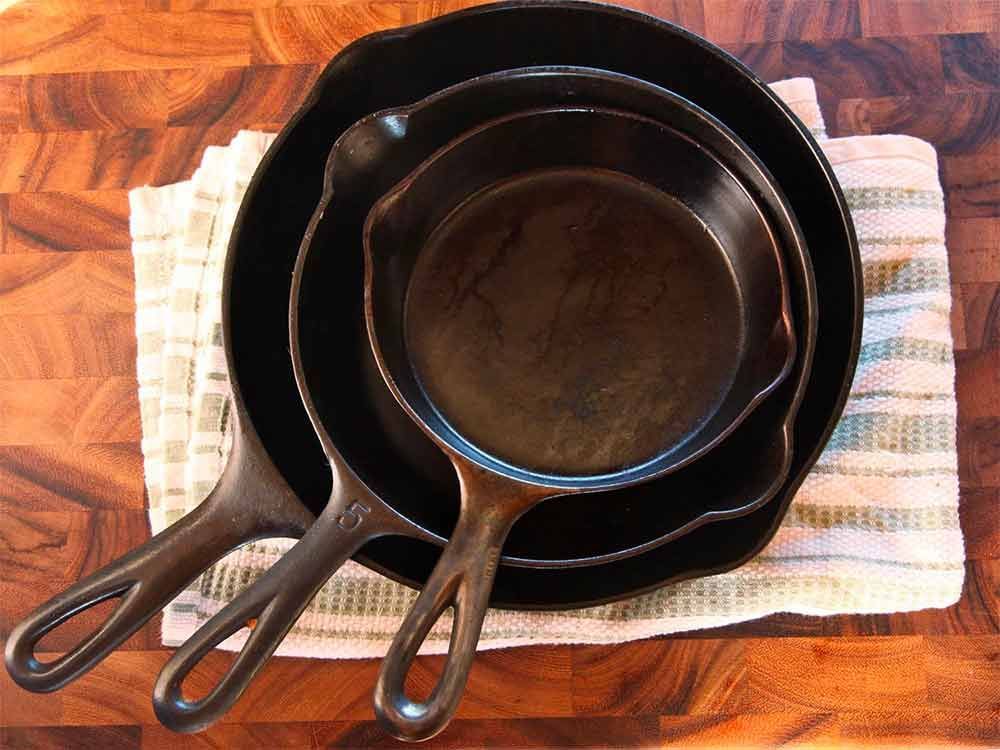
Things You Need to Know About Cast Iron Skillets
Though it’s true they offer many benefits, cast iron skillets have many quirks you must be acutely aware of.
Always keep in mind that cast iron is a fairly sensitive material that requires more care than either stainless steel or nonstick. Neglect or misuse it and before long you will have to send in your skillet for repair.
Cast Iron Skillets Will Become Rusty
Unlike stainless steel, which can resist rusting and corrosion well, cast iron can and will become rusty.
It’s important to understand that rusting is inevitable. Don’t be too stressed out if splotches of red rust start to form on your skillet after a while.

While you cannot prevent your skillet from rusting, you can control the rusting speed. Take good care of your cast iron skillet by cleaning it frequently and properly, and by storing it in a safe, dry space. If you follow these steps, you can keep the rust at bay for years.
Here’s another important thing to know: rust will not ruin your cast iron skillet. If you still want to use your old one, you have two options to restore it. The first is to bring it to a professional cleaner. The second (and more popular option) is to restore it yourself.
Fortunately, restoring a rusty cast iron skillet is a fairly simple process that can be done entirely at home. You just need some time and some elbow grease. We’ll go over this in more detail later in the article.
Seasoning
Seasoning is a protective layer of cooking oil that is bonded to the cooking surface of the skillet. The oil helps protect the skillet from rust and corrosion. It also makes the skillet less sticky and easier to cook with.
Each skillet is typically seasoned right on the production line before they are sold. Nonetheless, it is often recommended that you apply a second layer of seasoning at home just to be safe.
Maintaining and re-applying the seasoning when needed is a big part of the cleaning routine for cast iron cookwares.
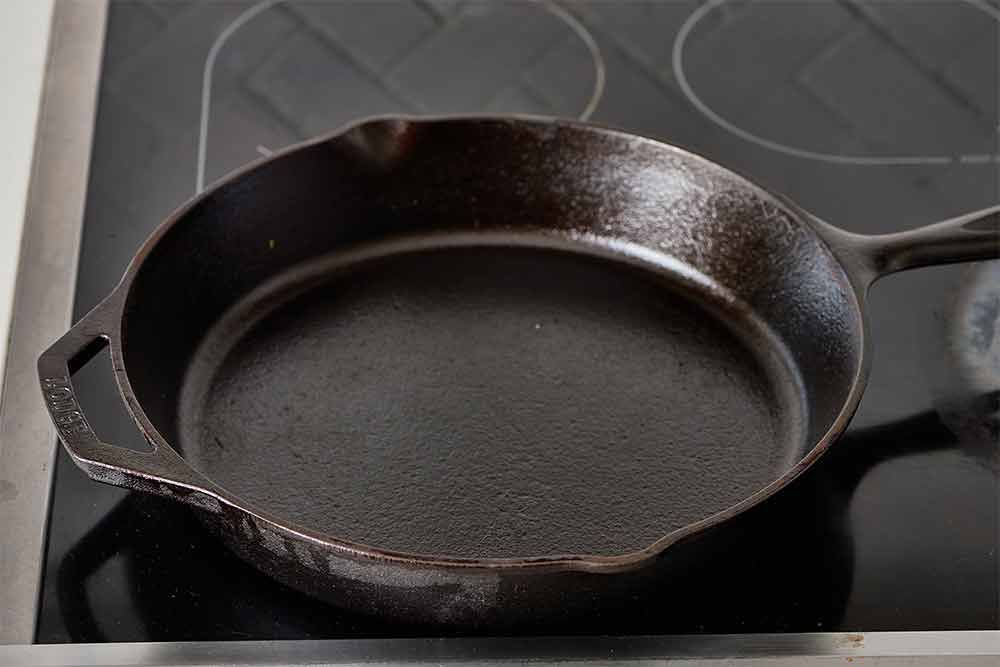
Unfortunately, the seasoning is one of the most misunderstood aspects of a cast iron skillet. In fact, most of the myths and misunderstandings surrounding cast iron cookware have to do with the seasoning.
Here are some of the myths.
Metal Utensils Can Ruin the Seasoning
Many cooks believe that they shouldn’t use metal utensils on cast iron skillets under any circumstances because they would ruin the seasoning.
In reality, it’s less of a problem than it may seem. The seasoning layer is highly durable and is solidly bonded to the skillet’s surface. You can use a fork to try and scrape at the bottom of the skillet and the seasoning will hardly budge.
That’s not to say that the seasoning is so hardy that it cannot be damaged. No, the seasoning does flake off every now and then (that’s why you have to frequently season your cast iron skillets). However, more often than not, these flakes are simply charred food bits left over from previous cooking sessions.
What we’re simply trying to say is that you shouldn’t develop an unhealthy fear of using metal utensils on your cast iron skillet. Using them occasionally is completely okay. The skillet and the seasoning layer are tougher than they seem.
Nonetheless, if you can help it, you should still use less-abrasive utensils like wood or nylon.
Soap Can Damage the Seasoning
This is the biggest myth that exists in the cast iron cookware community. The story goes that if you were to use even a tiny amount of soap on your cast iron skillet, the seasoning would be totally wiped out.
The reasoning behind this myth is that since soap removes oil, it will also wash the seasoning oil from the skillet.
It is partly true: soap is engineered to attack and wash off oil. However, the oil in the seasoning layer isn’t the same as your average cooking oil. It has been polymerized.
When the skillet is seasoned, the oil is repeatedly heated up. The oil will transform into a tough, plastic-like substance after this process. This is the reason why sticky food cannot latch onto a well-seasoned cast iron skillet and how it can resist rust formation.
The inertness that the polymerization process gives the seasoning layer prevents it from being easily washed off.
But this immunity is not complete. If you use concentrated detergent or too much soap, the seasoning may be washed off. This is the reason why a lot of people notice that the skillet becomes duller once they wash it with soap. Chances are high that they just used too much soap for the job.
Thus, if you were to ever wash your skillet, use only a small amount of soap. Just enough to keep the skillet clean and free from any bacteria or dirt.
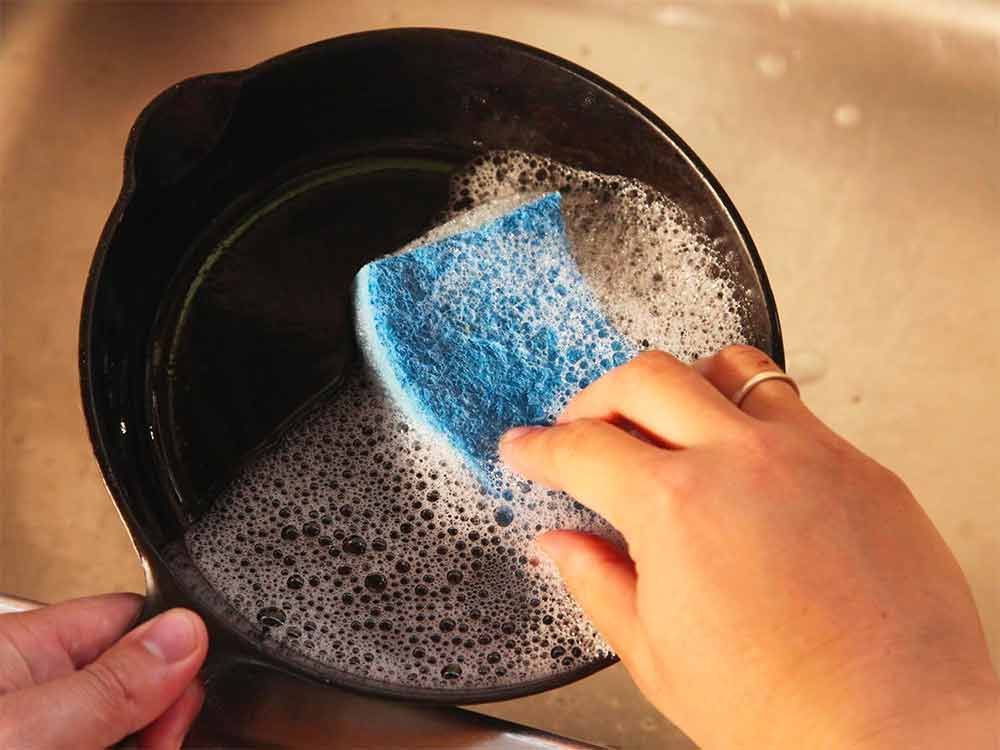
Replenish the seasoning often to make up for any degradation.
The Seasoning on New Skillets Is Better Than on Vintage Skillets
This is one of the most contentious issues surrounding cast iron cookware.
Vintage lovers believe that old skillets are made with more care and thus are superior quality-wise. Meanwhile, advocates for modern skillets claim that their skillets are better from the more advanced manufacturing techniques.
There are truths to both sides of the debate and it all comes down to manufacturing.
Vintage and modern cast iron skillets are made from the same material and the same process (sand casting). However, there’s one notable difference in the manufacturing between then and now.
Before the 1950s when cookware production lines hadn’t yet been streamlined, cast iron utensils like skillets were made with more care. Workers back then had to manually polish each skillet until they had a mirror-like, satiny finish. About 60% of all cast iron cookware made during this period underwent this extra polishing step.
However, because polishing is very labor-intensive, when production scaled up and became streamlined after the 1950s, the polishing step was removed. Consequently, modern cast iron skillets lack that glossy finish and instead have a bumpy texture.
The smooth finishing makes vintage cast iron skillets much less susceptible to sticking than the modern ones. Thus, vintage lovers are actually quite correct when they claim that old cookware is better.
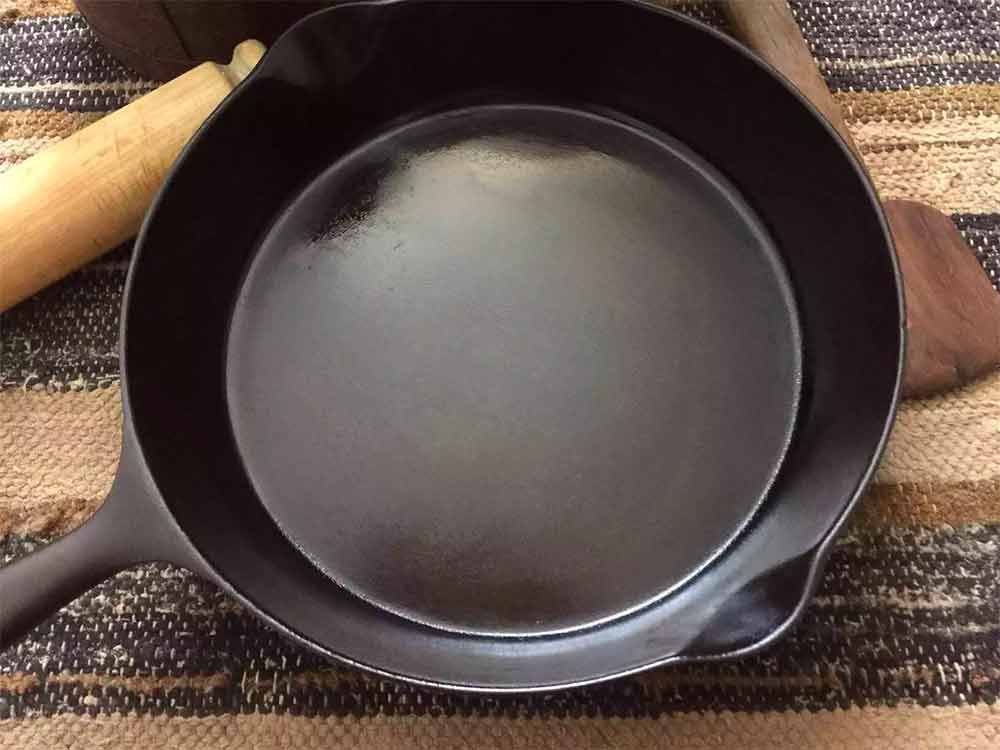
There is one small problem, though: the smooth surface makes vintage cast iron skillets slightly harder to season. The seasoning oil tends to have a harder time trying to grip onto the polished surface.
That’s where modern skillets come in. Their rougher, textured surfaces actually make them easier to season despite the slight loss in non-stickiness. The oil can hold onto the indents and bumps more easily.
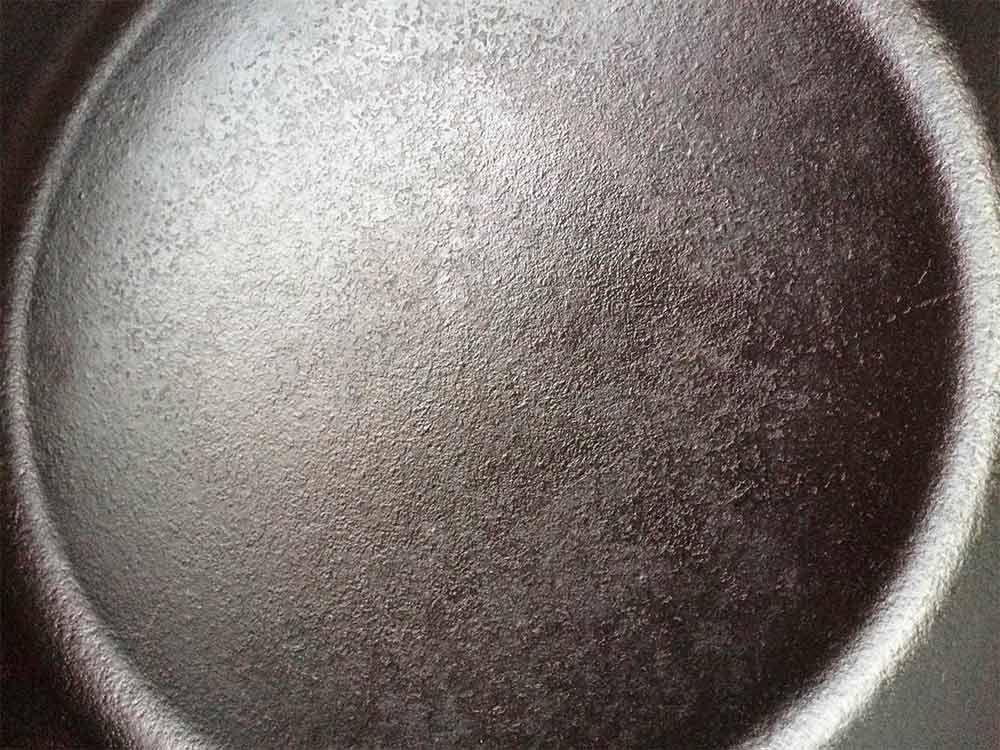
In the end, there’s no definite answer to this debate as to which is better.
It all comes down to personal preference. Both types, once properly seasoned, can cook very well. The only way for a cast iron skillet — regardless of age — to perform badly is from an unevenly applied seasoning.
As for how this can affect your cleaning routine: vintage and well-used skillets will require more effort to season. Conversely, you will have an easier time re-seasoning a new, textured cast iron skillet.
How To Season a Cast Iron Skillet
How To Season a New Cast Iron Skillet
Although new cast iron skillets are pre-seasoned in the factory, you should apply a second layer yourself. It’s not unheard of for a skillet to have a subpar factory-set seasoning.
However, even if the factory seasoning is good, it’s still recommended that you add three to four layers of seasoning to the skillet before cooking. It will build a good initial seasoning layer for your skillet and help it last longer.
Yes, that means you have to do the following process around three or four times:
- Preheat your oven to 350°F: You will have to “bake” the skillet to polymerize the oil.
- Wash down your skillet: Infuse some dish soap into hot water, soak the skillet in it and scrub it with either a sponge or a stiff-bristle brush.
- Thoroughly dry it out: With a dry cloth or paper towel, dry out the skillet. There shouldn’t be any moisture left on the skillet when you’re done.
- Oil it: Add oil onto the cooking surface of the skillet. We recommend certain oils with high smoke points like flaxseed (refined), soybean, and liquid canola oil. Such oils can create sturdier, more long-lasting, and more non-stick seasoning than their low smoke point counterparts. Avoid coconut oil and extra virgin olive oil at all costs.
- Distribute the oil around the cooking surface: Using some paper towels, evenly spread the oil around the skillet. Try not to leave any part of the skillet’s cooking surface untouched.
- Oil the exterior of the skillet: Do the same thing with the exterior of the skillet (outer rim, the sides, and the bottom). Every part — save for the handle — ought to be coated in a thin layer of oil.
- Bake: Put the oiled skillet upside down into the oven. To make sure that the oil won’t drip everywhere, lay a sheet of aluminum foil directly beneath. Heat the skillet for 1 hour.
- Cool down: Allow the skillet to completely cool down before you remove it from the oven. This may take a couple of hours. Once done, you can take it out and officially put your new cast iron skillet into use.

How To Re-season a Vintage Cast Iron Skillet
Vintage cast iron skillets, as expected, will require a little bit more work to reseason. Fortunately, the steps to re-apply the seasoning are the same as for a new one. It is the easiest and simplest part of the job, too. The most laborious portion is the cleaning and scrubbing to get the old gunks and rust off the skillet.
- Wash the skillet: In hot, soapy water, wash the whole skillet.
- Scrub off the gunk: An old skillet will have gunks and food debris collected on the cooking surface. Scrub it off using fine steel wool. Yes, you may see scratches and flaking due to the wool’s abrasiveness. However, that’s exactly what you want to happen here. That’s the dirt, rust, food gunk, and remnants of the old seasoning (which you will be reapplying anyway).
- Clean up with paper towels: Once all of the tough debris is wiped off with the steel wool, continue the scrubbing using paper towels. The soap and the wool will have dislodged and weakened the remaining gunk. Thus, wiping them down with paper towels is going to be easy.
- Wash and scrub the exterior: Once the skillet’s cooking surface is sufficiently clean, do the same thing for the exterior (rim, sides, and bottom).
- Oil and bake: Oil the skillet and bake it as you would a new skillet. Refer to the section above for details on how to do these steps.
- Check the seasoning’s integrity: When you have completed all of the seasoning steps and the skillet has cooled down from the baking, do a final check. Use a paper towel and wipe down the skillet’s cooking surface. If the towel is clean, the seasoning has settled in excellently and your skillet is ready to be used. If the towel is dirty, you may have to clean and re-season it for a second time.
Common Issues With Seasoning
Unfortunately, you won’t get a good seasoning every time. During the application process, the seasoning can run into various problems.
Here are a few common issues that you should watch out for.
Uneven Seasoning
Even the most adept cast iron cookware users can fall for this. If, after seasoning, your skillet looks a little bit dull, spotty, and has a brown tinge, it’s very likely that the seasoning is uneven.

When this happens, the seasoning won’t have as good a protective effect. If you use the skillet as it is, it will wear out faster. Food will also stick to spots with thinner seasoning.
There are many errors that can cause an uneven seasoning. Using too much oil, for example, can hinder the polymerization process and make the final seasoning splotchy.
Uneven seasoning will also occur if you use the wrong type of oil. Oils with low smoke points such as coconut oil and extra virgin olive oil will flake off. The result is bare, unprotected spots on the skillet.
However, most people don’t run into this problem because they use the wrong type of oil. Rather, it is because they use the wrong grade of oil.
Flaxseed oil, for example, is a very popular choice for seasoning. Nonetheless, it’s easy for people to mistake between refined flaxseed oil (100% flaxseed) and unrefined flaxseed oil.
Refined is the oil grade that you want for seasoning, as its smoke point is as high as 430°F. On the other hand, unrefined flaxseed oil has a very low smoke point of only 225°F. Accidentally buying and seasoning with the latter will cause your skillet to develop an uneven seasoning.
Technique can be the core of the problem here, too. If you forget to flip it upside down, the accumulated excess oil will also form a bad, spotty seasoning.
Ultimately, while there are plenty of possible reasons that the seasoning could be uneven, there’s only one way to fix it: scrub everything and try again. This is why you need to be aware and pay close attention to the procedure.
Over-Seasoned
Over-seasoning occurs when you either apply too much oil or build too much seasoning on the skillet.
You can recognize an over-seasoned skillet from its brown tint. A high concentration of carbon causes this brown tint. Additionally, if you were to touch the cooking surface, instead of feeling smooth and dry, it would feel sticky from residual oil.
There is no fix to this aside from scrubbing the seasoning off and reseasoning the skillet.
Under-Seasoned
If a skillet can be over-seasoned, it can be under-seasoned.
Under-seasoning is when the seasoning on the skillet is way too thin and doesn’t provide enough protection or non-stickiness.
You can identify an under-seasoned pan by its tendency to grip onto food (stickiness).
The texture and consistency of the skillet’s color can also be a red flag. Well-seasoned skillets are usually shiny and have a consistent dark color all throughout the cooking surface. A dull and blotchy skillet is a big sign of under-seasoning.
You can also try wiping down the skillet with a paper towel. Your skillet is definitely under-seasoned if you find black residues on the paper towel.
The fix is quite simple: season it again.
How To Clean a Cast Iron Skillet After Cooking
Just like every other kitchen utensil, you must thoroughly clean your cast iron skillet after every cooking session. Due to cast iron’s reputation for being a sensitive material, many people are anxious about washing their cast iron skillet. Some are afraid that contact with water will rust away their skillet. Others think that soap will wash off the seasoning.
The truth is that you’re more likely to ruin your cast iron skillet if you don’t clean it appropriately with water and soap. Food debris and gunk can deteriorate the seasoning if left uncleaned for long periods of time. The weakened seasoning will pave the way for rust to form quicker.
Therefore, don’t be shy about giving your skillet a methodical wash. The pros far outweigh the cons. Here are the steps to take right after you finish cooking.
- Scrape all visible food debris from the cooking surface: With a spatula, remove any debris that you can find on the surface.
- Deal with stuck debris: You can refer to the burnt-on food debris removal guide below to know how to remove especially stubborn debris. It contains details on how to extract it.
- Wash in cold water: Since we don’t intend to strip the seasoning, unlike earlier with guides, we use cold water. Hot water will cause the seasoning to come off. The water will wash away all of the leftover grease and food bits.
- Thoroughly dry the skillet: Dry the skillet with a clean cloth or paper towels. Make sure that there’s no moisture left on the skillet by the time you put it away.
Important: Do not attempt to put your cast iron skillet into the dishwasher.
How To Clean a Rusty Cast Iron Skillet
As we mentioned earlier, all cast iron skillets are susceptible to rusting. It is only a matter of time. However, do not throw out your cast iron skillet! You can restore and reuse it quite easily.
Professional Restoration vs. At-Home Restoration
Professional Restoration
If you have a rusty cast iron skillet on your hands, there are two roads you can take.
Your first option is to send it to a professional restorer. Professional restorers have sand-blasting machines that can scrub off the heavy rust and reveal the iron beneath.
You should only pick this option if you have a vintage cast iron skillet that has some serious rusting. Only then will the money and time spent be worth it.
At-Home Restoration
If your skillet only has slight rusting, you can just do it at home. It doesn’t take more than an hour or two to completely restore your skillet to its original condition.
Re-season your skillet afterward. The cleaning process will have stripped off much of the seasoning along the rust.
Just follow the steps here.
- Use steel wool to scrub off the rust: Remove as much of the rust from the skillet’s surfaces as you can until bare cast iron is revealed. Scrub not just on the cooking surface, but the other parts of the skillet like the sides and the bottom. Additionally, make sure that you use fine steel wool. Medium or coarse steel wools may damage the skillet.
- Wash the skillet: Wash the skillet using hot water and a small amount of dish soap. Use a sponge or a stiff-bristle brush to wipe away any debris, gunk, or remaining rust on the skillet.
- Thoroughly dry: With a clean cloth or paper towels, dry the skillet. The skillet should be completely dry.
- Re-season: Re-season the pan using the steps laid out in the earlier section. Once applied, let dry, and you can use the skillet normally from then on.
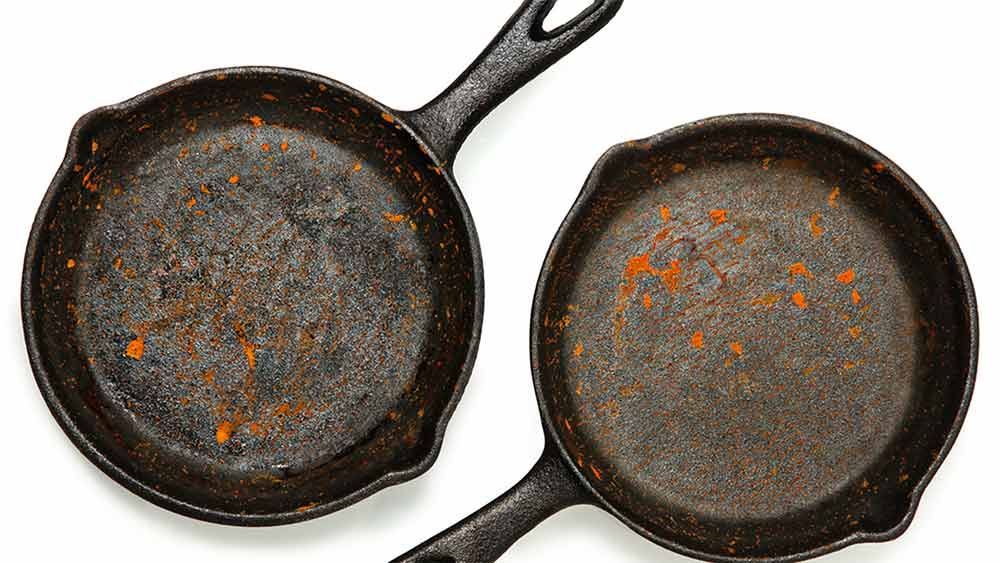
How To Clean a Cast Iron Skillet With Burnt-on Food Debris
You may find burnt food debris on the skillet when you finish cooking. These debris must be removed. Else, they will damage the skillet in the long run by wearing out the seasoning. The best technique to use to remove this will depend on how much it has carbonized.
How To Clean Lightly Stuck Burnt Food Debris
You can remove the burnt debris quite easily if it’s only stuck superficially to the skillet’s surface.
First, allow your skillet to cool down from piping hot to warm. Once the cooking surface is sufficiently cool, add about 1 to 2 tbsp of cooking oil onto the surface.
With a paper towel, wipe the cooking surface with the oil. Any superficially-stuck debris will be dislodged off by the oil.
How To Clean More Stubborn Burnt Food Debris
For food debris that is more burnt and stuck more stubbornly, you may need to be more heavy-handed. Cooking oil will not suffice.
In this method, you can use either coarse salt or baking soda.
Sprinkle an ample amount of your choice of cleaner onto the skillet, then use a paper towel to scrub the debris. The abrasiveness of the coarse particles should dislodge it.
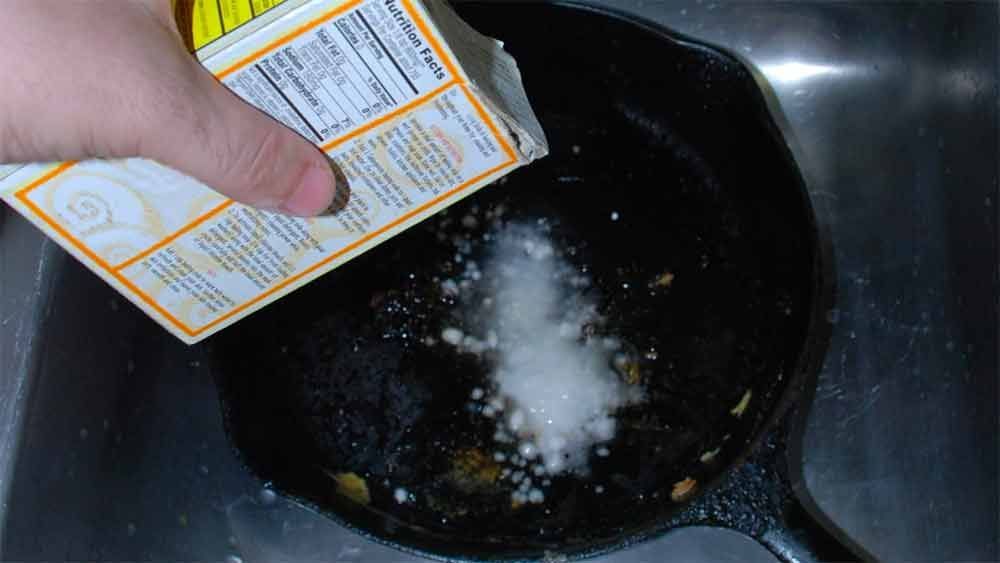
Wash away all of the baking soda and salt by washing the skillet under tap water.
How To Boil Off Tough Burnt Food Debris
If salt and baking soda don’t work, you will have to use the last method: boil it off.
First, fill up your skillet with about an inch of tap water. Place the skillet on medium heat until the water starts to boil. When the water starts bubbling, scrape the cooking surface with a spatula. Any debris or gunk on the surface will come off at once.
We recommend re-seasoning your skillet. A portion of the seasoning will have already flaked off during the process.
How To Clean Black Residue Off Cast Iron Skillet
If you find an inky, charcoal-like black residue on your iron skillet, there are three common reasons that can explain its appearance:
- Leftover food bits: Food debris, if not cleaned properly, can become charred and stick to the skillet.
- Burnt oil: The residue can form if you push a cooking oil past its smoking point. For example, if you heat extra virgin olive oil beyond its smoke point (around 375°F), it will carbonize and form the black residue.
- Burnt seasoning: When the seasoning is burnt off, black seasoning will form. New cast iron skillets are especially susceptible to this problem. The factory-applied seasoning layer is usually very thin. Thus, you can accidentally burn it off fairly easily. This is one of the many reasons why it’s recommended that you season your skillet immediately after buying.

Although there are no clear studies into this black substance (which is essentially a carbon deposit), the general consensus is that they are not harmful. Thus, it is more of a nuisance than a serious safety threat.
We have two methods that you can use to clean this black residue from your skillet.
Salt & Soap Method
This is the most popular method. As the name suggests, it involves a bit of coarse salt and detergent to dissolve the inky substance.
- Add salt and soap to the skillet: Put ¼ cup of coarse or Kosher salt and ¼ cup of detergent into the skillet.
- Scrub the skillet: With a clean cloth or rag, scrub the skillet. Because this black residue can form on all parts of the skillet, clean all throughout the skillet and not just the cooking surface.
- Wash in warm water: Wash the salt/detergent mixture from the skillet in warm water, scrubbing all the while. By the time you turn the tap off, no visible trace of salt or detergent should remain.
- Dry: With a dry, clean cloth or paper towels, wipe the skillet from top to bottom. No moisture should remain.
- Heat the skillet to remove remaining moisture: Heat the skillet on the stove top using medium heat if you want to be extra certain that it’s completely dry. All remaining moisture will boil away.
You will have to re-season your cast iron skillet after this procedure.
Vinegar & Baking Soda Method
The other alternative is to use vinegar and baking soda. This method will be better if your skillet has a lot of black substance built up on the surface.
- Mix equal parts vinegar and water in the skillet.
- Boil the mixture: Use medium heat to bring the vinegar/water mixture to a boil. Allow the mixture to boil for 1 minute.
- Add baking soda: Add 1 tablespoon of baking soda. The mixture will immediately begin to bubble and hiss.
- Scrub the skillet with a scouring brush: Wipe the black residue off of the pan with the brush. Submerged in the potent vinegar/water mixture, it should come off easily.
- Wash and dry: Wash the skillet in warm water and dry thoroughly before storing.
- Re-season.
If a thick layer of black residue has built on your skillet, you will need to use the soak method. This method is most suitable for old, seriously rusty skillets.
Find a sink or a vessel that is large enough for the skillet to be submerged into. Mix equal parts water and vinegar in the vessel and soak your cast iron skillet in the mixture for an hour.
After an hour has passed, take the skillet out. With a stiff-bristle brush, scrub the cooking surface or any part that’s covered in the black substance.
Place the skillet back inside the mixture and soak for another hour. If there are still dark spots on the skillet, take it out and scrub again.
Keep on doing this until the skillet is completely clean. Rinse the skillet under tap water and dry with a clean cloth.
Re-season the skillet afterward.
How To Care For Cast Iron Skillet
Aside from knowing how to properly clean your cast iron skillets, you should also know and practice caring for them. The better you care for them, the longer they last and the less maintenance or overhauls you will have to do.
You can do a couple more things besides appropriately and frequently seasoning the skillet (which has already been discussed).
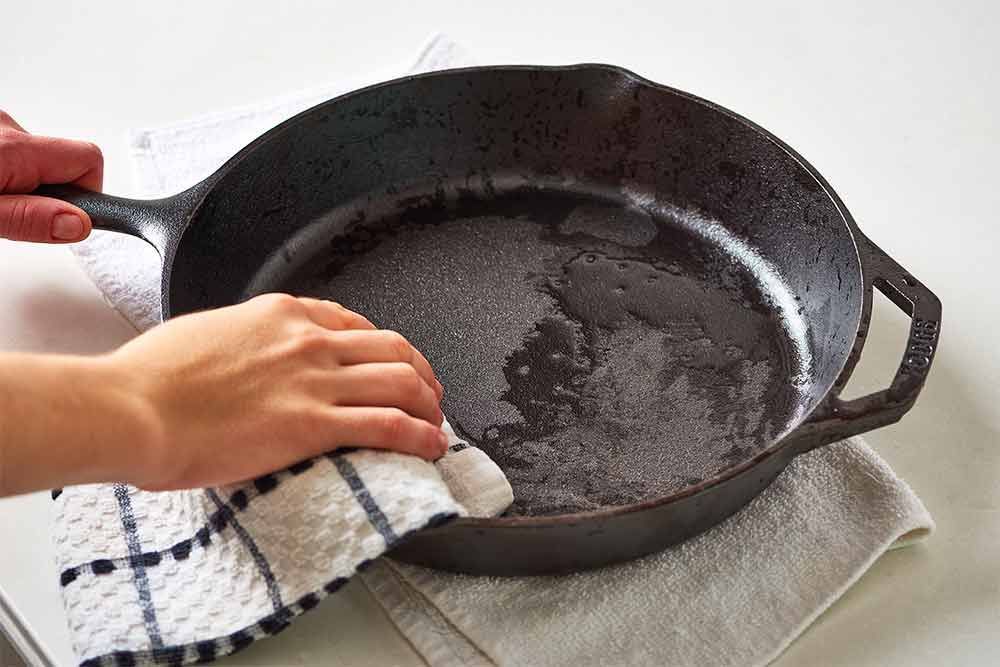
Post-Cooking Seasoning
You should lightly re-season your skillet after every cooking session. You can replenish whatever seasoning that has been lost either during the cooking or cleaning process this way. Additionally, it builds up the skillet’s rust resistance and fends off any rusting that may occur in storage.
Pour a thin layer of your seasoning oil onto the skillet and place it on the burner for a couple of minutes until the oil begins to smoke slightly. Cut off the burner at this point.
Allow the skillet to cool before storing.
Storage
Though it may sound unimportant, correctly storing your cast iron skillet can drastically affect its lifespan and health.
Ensure that your skillet is totally dry when you put it away. If you don’t, rust can form on the skillet and eat away at the seasoning.
As for where to store the skillet, if you frequently use it, anywhere that is dry will be fine. You can even store the skillet alongside other pots and pans in the house. As long as you keep moisture away, there will be no issue.
If you plan to store it long term, you need to take extra precautions against rust.
The first thing to do is to thoroughly clean the skillet (refer to the guides above for details). Then, coat the skillet with a thin layer of food-grade mineral oil.
Mineral oil can protect the skillet from rust in a similar way to seasoning. However, unlike the cooking oil used in the seasoning process, mineral oil doesn’t go rancid. Thus, it is the ideal substance to use for long-term storage of cast iron skillets.
When you need to use the skillet again, wash off the mineral oil with mild dish detergent and water. Then, re-season your skillet, and use the skillet as normal.
Be Mindful of What You Cook
There are certain foods that work best for cast iron skillets. The best foods to cook are meats that are high in fat content (such as steaks and chicken quarters). Fried foods are also excellent for cast iron skillets, as well as one-pot recipes like casseroles and roasts.
But there are certain foods that you should avoid where possible, such as acidic food. Dishes with tomatoes, limes, lemons, and other acidic ingredients aren’t good fits for cast iron. The acid can eat away at the iron and leach it out of the skillet. The result is a metallic aftertaste to whatever food that you just cooked.
Acidic food also negatively affects the seasoning, wearing it away quicker.
The metallic taste is not harmful, mind you. As a matter of fact, the higher iron content in the food is beneficial if you are anemic. However, some people just don’t take well to tasting iron in their food.
If you must cook these dishes using your cast iron skillet, make sure that the recipes take less than 30 minutes to complete. Once you finish cooking, transfer the food immediately into a plate or container and wash the skillet. Do not attempt to store the food in the skillet.
Conclusion
Even though a cast iron skillet is difficult to use, for a lot of people, it is well worth the time and effort. We hope this guide on how to clean a cast iron skillet has made it clearer for you.
